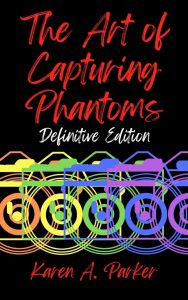
Unleashing the Imagination: A Review of ‘The Art of Capturing Phantoms’ by Karen A. Parker

The Art of Capturing Phantoms
by Karen A. Parker
Genre: Short Story Collection
ISBN: 979-8849760223
Print Length: 198 pages
A collection of experimental flash fiction that lyrically explores the intersections between real and imagined worlds
Karen A. Parker’s “The Art of Capturing Phantoms” takes readers on a journey through sketches, flash fictions, and anecdotes that push the boundaries of storytelling and imagination. With each story ranging from 200 to 2000 words, Parker defies conventional genre and form, delving into the intricate relationships between people and their surroundings.
The collection is a testament to Parker’s mastery of worldbuilding. In one story, a conversation unfolds between a skeleton and a mermaid seeking flight through collecting anchors from the ocean. In another, titled “A Cardboard Box,” the narrator’s experience of homelessness is portrayed through the lens of a simple cardboard box. Each world is meticulously constructed and subtly unveiled, giving readers the sensation of having been immersed from the beginning. Parker’s experiments are complex, intricate, and undeniably captivating.
The author’s strength lies in crafting within tight parameters, and they are well aware of it. Following each story, Parker provides footnotes discussing their creative process. Many of the prose pieces, previously featured on Parker’s blog, were born out of daily writing challenges inspired by prompts found online. For instance, the final story in the collection reveals that Parker was tasked with creating an Alien character with a mask as a prop. Another notable example is “ABC Fortunetelling,” an abecedarian form where each sentence must start with consecutive letters of the alphabet. The footnotes shed light on the difficulty of adhering to such constraints and question the feasibility of creating while strictly following the form.
While the adherence to constraints and prompts is impressive, they occasionally hinder the storytelling. In the abecedarian piece, the line “Xenophobic witch-haters–every one of them” feels forced within the context of the story, inserted solely to comply with the constraints. Additionally, some stories feel like concept sketches rather than fully fleshed-out narratives, leaving the reader yearning for more.
However, the footnotes elevate the book as a whole, transforming it into more than a mere collection of short fiction. They blur the lines between genres, venturing into autofiction or memoir territory. The footnotes share how real-life incidents, such as “crying on my fifth birthday for no discernible reason,” served as inspiration for certain stories. In another note, Parker reflects on the idea of growing into one’s emotions. By incorporating footnotes, as well as a Foreword and Preface, “The Art of Capturing Phantoms” becomes an account of the author’s personal journey. It explores the writer’s emotions and growth as they experiment and reflect, ultimately becoming a more accomplished storyteller. Through uncaged inventiveness and lyrical prose, Karen A. Parker proves themselves to be a promising rising writer.
Overall, “The Art of Capturing Phantoms” is a thought-provoking collection that pushes the boundaries of storytelling and showcases Parker’s talent for worldbuilding. While some stories may feel incomplete or constrained by prompts, the inclusion of footnotes adds a layer of depth and transforms the book into a compelling exploration of the author’s creative journey.






